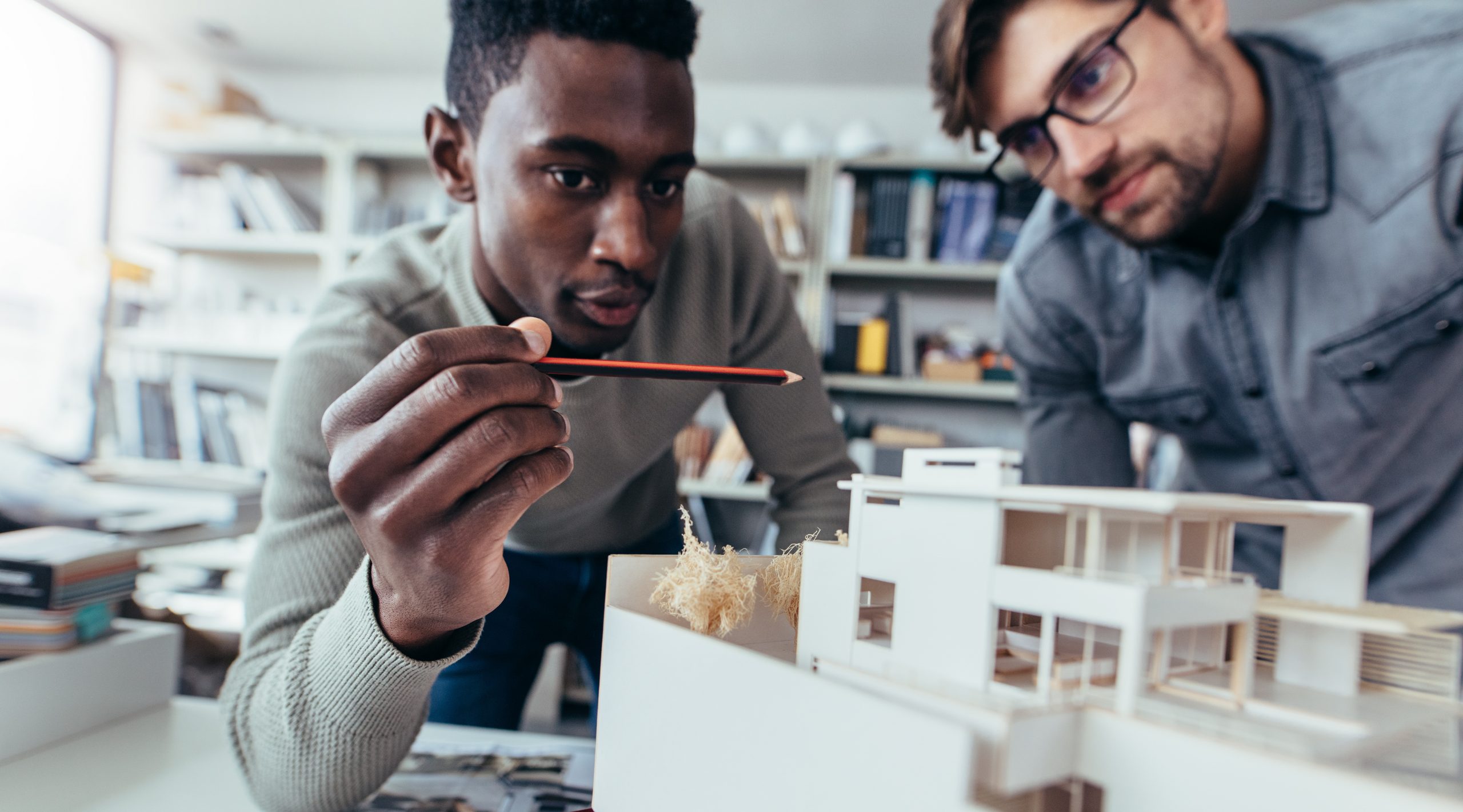Architect Interview Questions You Should Be Equipped to Answer
Architect Interview Questions You Should Be Equipped to Answer
Blog Article
Recognizing the Diverse Occupation Paths Available for Aspiring Architect
As a hopeful Architect, you have a globe of occupation paths waiting on you. Each course provides one-of-a-kind difficulties and possibilities to apply your imagination and technological knowledge. Whether you're attracted to traditional design or the subtleties of sustainable style, there's a niche that aligns with your rate of interests. Recognizing these diverse options can shape your expert trip, but which instructions will you choose to check out initially?
Standard Style: Designing Buildings and Structures
Conventional style concentrates on making buildings and frameworks that mix performance with aesthetic allure. As you explore this area, you'll value the elaborate balance between kind and function. You'll find out to attract ideas from historic designs, including elements like symmetry, products, and craftsmanship. Your designs can reflect cultural heritage, showcasing neighborhood practices while fulfilling modern needs.
You'll establish skills in composing, model-making, and website evaluation, enabling you to imagine and communicate your ideas efficiently. Engaging with customers, you'll require to comprehend their vision and translate it into viable layouts.
Furthermore, building codes and sustainability methods are important in your job, guaranteeing your structures are safe and eco-friendly. As you expand in your profession, you'll find possibilities in residential, business, or perhaps restoration jobs, each offering distinct challenges. Accepting conventional style paves the way for a meeting occupation that admires the past while shaping the future.
Urban Preparation: Forming Neighborhoods and Public Spaces
As an ambitious Architect, you can play an important duty as a metropolitan organizer, transforming exactly how areas work and connect. By employing community involvement techniques, you'll assure that homeowners have a voice fit their environment. And also, integrating lasting design concepts will help produce areas that not just meet today's demands but additionally safeguard the future.
Role of Urban Planners
While numerous might think of architects as the sole visionaries behind buildings, urban planners play a vital function in forming the wider landscape of neighborhoods and public areas. By collaborating with various stakeholders, you'll help design parks, transportation systems, and property locations that promote social interaction and availability. Your expertise in spatial design and area characteristics allows you to visualize future development while preserving social heritage.
Area Interaction Approaches
Reliable area interaction approaches are essential for metropolitan planners to assure that the voices of citizens are heard and valued in the planning procedure. To promote purposeful discussion, you should focus on open online forums and workshops where area participants can reveal their ideas and worries. Use surveys and social networks to get to a wider target market, making sure varied viewpoints are consisted of. Working together with local companies can boost count on and help with much deeper links. It is necessary to offer clear details regarding suggested jobs and decision-making processes, permitting residents to feel informed and encouraged. By actively including and listening comments, you'll develop spaces that reflect the neighborhood's demands, ultimately causing even more sustainable and effective city settings. Embrace transparency and constant dialogue for long-term influence.
Sustainable Design Principles
When making metropolitan spaces, including sustainable style principles is crucial for developing atmospheres that thrive both environmentally and socially. Think about incorporating eco-friendly spaces, like gardens and parks, to boost biodiversity and enhance air top quality.
Designing with water preservation in mind is likewise key-- think of rainfall gardens and absorptive surface areas to handle stormwater. Entailing neighborhood members throughout the preparation process warranties that the areas you develop meet their demands and encourage social communication. By embracing these principles, you'll add to dynamic, lasting city landscapes that benefit every person.

Landscape Style: Producing Sustainable Exterior Atmospheres
As you explore landscape style, you'll find vital design concepts that produce useful and beautiful outside rooms. Lasting techniques play a crucial role in ensuring these settings flourish while decreasing environmental influence. Plus, you'll locate a range of job chances that permit you to make a genuine distinction in how individuals interact with nature.
Style Concepts in Landscape
Understanding design principles in landscape architecture is crucial for developing lasting exterior settings that balance with nature. You'll require to contemplate elements like proportion, balance, and range to assure your styles really feel cohesive and welcoming. Additionally, pay interest to seasonal changes, developing with materials that enhance the environments year-round.
Sustainable Practices Overview
Lasting methods in landscape style not only focus on visual appeals however additionally prioritize ecological health and wellness and source conservation. You can develop areas that advertise soil health, such as exercising and using organic materials permaculture principles. Inevitably, these practices guarantee your designs benefit both people and the environment for years to come.
Profession Opportunities Exploration
With a solid foundation in sustainable techniques, landscape architecture offers a selection of profession courses that enable you to make a significant influence on the atmosphere. Urban planners often work together with landscape architects to develop eco-friendly rooms in metropolitan setups, improving city livability. If you're enthusiastic regarding education and learning, take into consideration ending up being a landscape architecture teacher, motivating future generations.
Lasting Layout: Focusing on Eco-Friendly Practices
As you discover your career in design, embracing eco-friendly methods can establish you apart in a competitive area. Lasting design concentrates on developing buildings that reduce ecological impact while improving owner well-being. By integrating eco-friendly products, energy-efficient systems, and sustainable building methods, you'll add to a greener future.
Start by getting expertise of green accreditations like LEED or BREEAM, which can strengthen your qualifications. Consider exactly how all-natural light, air flow, and thermal efficiency can optimize style. Team up with designers and environmental specialists to introduce solutions that decrease waste and save sources.
Do not neglect the value of community involvement-- engaging local stakeholders can influence styles that balance with the atmosphere. As customers increasingly prioritize sustainability, your experience in eco-friendly practices will not only attract projects yet additionally fulfill your enthusiasm for liable architecture. Accept this crucial facet of the career, and see your occupation flourish.
Historic Preservation: Safeguarding and Restoring Cultural Heritage
While you start on your the original source building journey, take into consideration the necessary function of historic preservation in keeping our social heritage. This field focuses on the protection and restoration of substantial structures, sites, and structures that tell the stories of our past. By participating in historical preservation, you'll help guard the building legacy that forms area identity.
As a historic conservation Architect, you'll examine historical significance and examine the condition of frameworks. You'll work carefully with conservationists and chroniclers to guarantee genuine restoration methods are employed. This profession course allows you to mix creativity with research study, allowing you to develop remedies that appreciate initial materials and craftsmanship.
Your job not just adds to sustainability by recycling existing structures however additionally fosters a feeling of satisfaction within communities. Accepting this course will assist you end up being a guardian of background, protecting the tales and visual appeals that enhance our lives.
Interior Architecture: Enhancing Indoor Spaces
Historic conservation and interior design both share a commitment to improving the built atmosphere, yet they focus on various facets. While historic preservation emphasizes keeping a structure's cultural and historic worth, interior architecture zeroes in on enhancing indoor areas for functionality and aesthetic appeals.
As a hopeful Architect, you'll discover that interior style permits you to mix creative thinking with technical abilities. You'll create spaces that not just look excellent yet also promote convenience and efficiency. This field entails recognizing just how light, shade, and materials connect within an area, influencing click to investigate mood and use.
You'll service different projects, from domestic homes to business offices, ensuring that each setting meets the needs of its occupants. By prioritizing individual experience, you can change interiors into practical and motivating spaces, making a considerable influence on exactly how individuals engage with their surroundings. Accept the chance to improve interior settings and shape the means individuals function and live.
Industrial Design: Combining Capability With Aesthetics
Industrial design plays a vital role in creating products that perfectly blend looks with functionality, ensuring that what you use everyday is not only aesthetically appealing yet also practical. As an ambitious Architect, you can involve yourself in this field, concentrating on developing everything from furnishings to consumer electronics. Your job involves comprehending customer demands, materials, and producing procedures, enabling you to create innovative services that improve daily experiences.
In industrial design, you'll commonly work together with designers, marketers, and producers, guaranteeing that your designs are not only beautiful yet additionally practical. This occupation path offers a vibrant atmosphere where creativity meets practicality, making it a rewarding selection for designers interested in forming the items of tomorrow.
Often Asked Questions
What Educational Qualifications Do I Required to End Up Being an Architect?
To come to be a designer, you'll require a specialist degree in style, commonly a Bachelor's or Master's. In addition, you'll have to complete a teaching fellowship and pass the Architect Registration Exam to practice legally.
Exist Qualification Demands for Various Architectural Job Paths?
Yes, there're qualification needs for various architectural courses. Architect. You'll need to pass examinations, total internships, and sometimes go after specialized training, depending on your selected emphasis, like landscape architecture, metropolitan design, or historic conservation
What Software Application Abilities Are Necessary for Architects Today?

Exactly How Can I Gain Practical Experience While Studying Architecture?
You can gain practical experience by interning at building firms, taking part in layout competitions, volunteering for community tasks, or collaborating with schoolmates on real-world projects. These chances enhance your skills and build beneficial connections in the sector.
What Task Opportunities Exist Outdoors Conventional Style Firms?
You can check out numerous job possibilities outside typical style firms, like metropolitan preparation, interior decoration, landscape style, building management, realty advancement, or also duties in sustainability consulting. Each offers distinct obstacles and incentives.
Whether you're drawn to conventional style or the subtleties of sustainable style, there's a niche that straightens with your interests.When developing metropolitan rooms, including sustainable style concepts is crucial for developing environments that thrive both environmentally and socially.As you explore landscape architecture, you'll find crucial style principles that produce attractive and useful outdoor spaces.Comprehending style principles in landscape architecture is vital for producing sustainable outside atmospheres that balance with nature.In industrial design, you'll typically work together with engineers, marketing professionals, and suppliers, guaranteeing that your designs are not only beautiful yet additionally practical.
Report this page